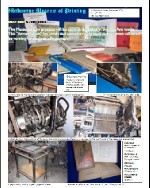Melbourne Museum of Printing

Preserving not only the machines and artefacts of printing but also the knowledge. Recreating the workplace environment to encourage senior craftsmen to pass on their skills and younger designers and printers to understand what came before their computers.
The Museum's main audience is teachers and students of Graphic Design, Typography, Writing & Editing, Book Arts, Printmaking, Librarianship, Publishing.
Courses are offered to understand the historical development of typesetting and printing.
General public, tourists and social groups are welcome.
Think about any book or paper printed before about 1900. Every letter on every page had to be picked out from a typecase and assembled into words. See how it was done and is still done (by very keen people).
See the Linotype machine that did the same job faster from around 1900., still in regular use. See the hand press dating from 1849, still used by visiting artists.
Find out about typefaces, points and picas, platen presses and cylinder presses, the development of lithographic printing and how it took over from letterpress printing.
The Access Studio is available (fee applies) for anyone to
typeset by hand and print by hand their own poster, book, invitation, card, folio piece or experimental art. Training and supervision is included.
Research Access is possible to our archival material, believed to be the only substantial collection of its kind in the world.
Closed over Christmas and New Year except by appointment (mainly for out-of-town visitors).
Groups of more than six are requested to book.
See website [contact page] for more detail.
133 Cowper is near the corner of Parker Street.
Building is accessible except for toilet.
Facilities and equipment for typesetting and printing.
Hand and machine typesetting and making the letters (types) for use in hand typesetting.
Engravings, stereotypes, early typewriters, all on show and all can be explained.
Presses (hand operated) and printing machines (power operated).
Archival material relating to the printing industry of the 20th century and the customers it served. Includes thousands of "standing jobs" (where the typesetting was kept intact rather than being broken up and put away), blocks (for illustrations), stereotypes (check out what a stereotype really is) and documents relating to these jobs.
One of our main aims is to show not only how things work but also the working environment, with realistic numbers of machines. Although our present small venue limits us in this endeavour, we have the breadth and depth in our stored collection for when we move into larger premises.
